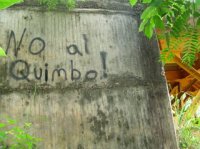
Since January 2012, the Upper Magdalena River is the scene of some bold civilian struggle for environmental justice. Communities affected by the proposed El Quimbo Dam project paralyzed dam construction by blocking a bridge and road access for 15 days. The El Quimbo Dam is a concrete faced rock-fill dam (CFRD) and hydroelectric power project whose works were officially opened on February 25, 2011.
Civilians are concerned about the flooding of 8500 hectares of fertile lands, the displacement of some 1,500 inhabitants and the uprooting of eight cottage industries and various jobs in the local economy. More than 15,000 people in Huila state depend on such resources for employment and food production. Their struggle against Goliath- the project is realized by Emgesa, a Colombian subsidiary of the Spanish electricity giant Endesa, in turn owned by Italian giant ENEL – has already prevented dam construction from moving forward.
“During the past four years, the project has caused ecological destruction, psychological trauma for locals and increased the cost of living,” said Miller Dussan, a professor at Surcolombiana University in Neiva, Huila state, and defender of the river. “The Quimbo construction site dumps a variety of liquids and other pollution into the river. Before construction started on the dam, a family could catch up to 40lb. of fish a day; now a family is lucky if they can catch 8 lb. There is no way to live with that” said Miriam Restrepo, a local fisherwoman who took part in the strike. “The company does not want to compensate us because they say the project won’t affect us.”
As a result of the occupation, several high government authorities agreed to sign an agreement with local communities that will result in a review of the project’s impacts and of the legal process that approved its construction, and the implementation of protections for affected peoples and ecosystems. Senator Alexander López requested the suspension of the diversion of the Magdalena River to prevent irreversible damage. One can remain skeptical. In 2010 Chinese company Hydrochina signed an agreement with the Colombian government to create the ‘Master Plan for the Exploitation of the Magdalena River.’ How are Colombians going to be involved in the decision-making process regarding hydropower development in the Magdalena River?
Despite petitions and mass protests, the police evicted 600 protesters with brute force on February the 14th, in which at least 3 protesters were harmed. People trying to get back to their land have been removed by the police and an Italian activist, Bruno Federico, has been arrested. Italy is involved in this issue because ENEL, the Italian company, is at the top of a long chain of responsibility and ownership.
As we write, further civic resistance to avoid the works from beginning is due to take place today, Monday 20 Feb.
International Rivers collects information on this and many other water conflicts. You can find more information on their campaigns through their website.

The project ENVJUSTICE has received funding from the European Research Council (ERC) under the European Union’s Horizon 2020 research and innovation programme (grant agreement No. 695446)